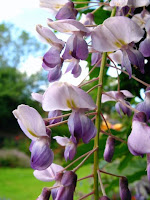






 I bought this Aristolochia grandiflora from Worldfarm on Saturday. It was the second time I saw it for sale and judging by how quickly it was snapped up the first time around, I decided not to miss the boat and promptly bought myself a pot for just S$18.
I bought this Aristolochia grandiflora from Worldfarm on Saturday. It was the second time I saw it for sale and judging by how quickly it was snapped up the first time around, I decided not to miss the boat and promptly bought myself a pot for just S$18. Commonly known as the Dutchman's Pipe, the A. grandiflora is an aggressive vine which does well in full sun. Even with the kind of dry weather we have been experiencing, the vine didn't wilt in the heat. Unlike other species of Aristolochia, the grandiflora produces one of the largest flowers. It also emits a rather foul odour, akin to rotten garbage. The stench is meant to attracts flies which help pollinate the flower. The pollination process is rather interesting. Flies and bees would venture into the throat and get trapped by backward pointing hairs that prevent them from retreating. The insects fall into the swollen tank at the base where they trash around until they pollinate the flower. Once this is done, the hairs wilt and the insects escape to pollinate another flower.
From the look of things, the stench didn't just attract the flies. It also attracted the attention of the dogs who were probably wondering where the horrid smell came from.



























































